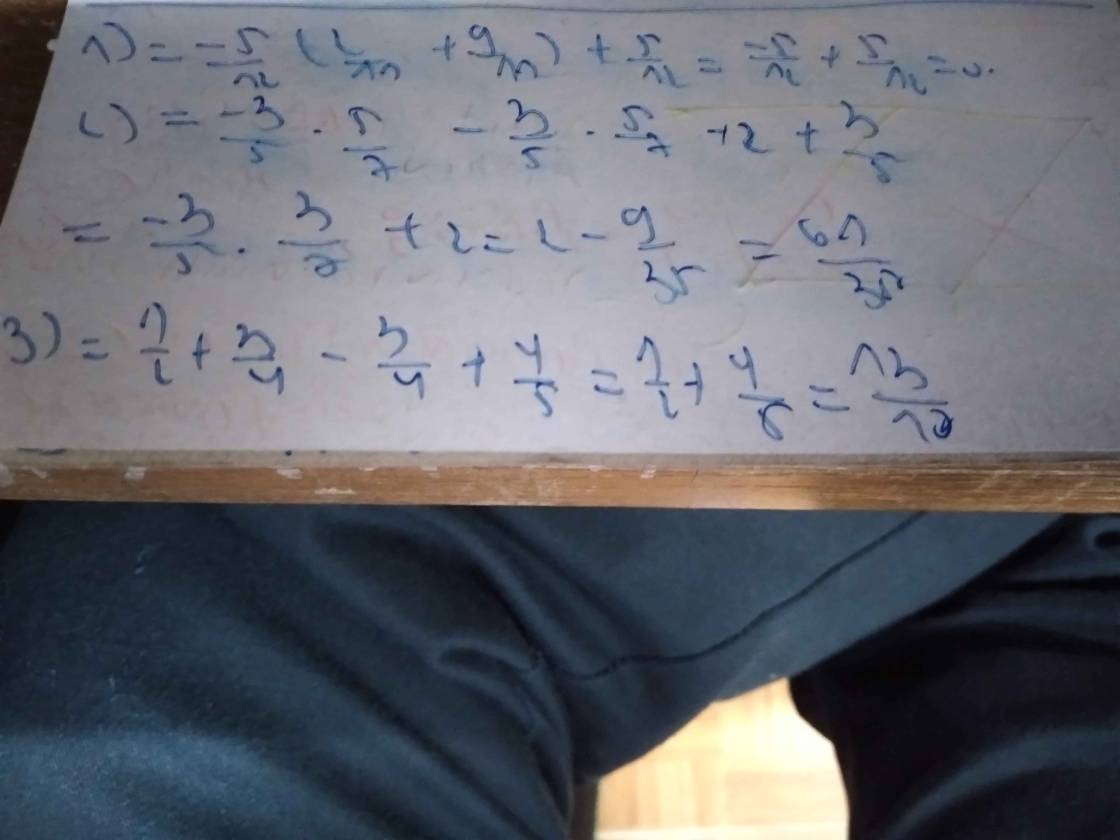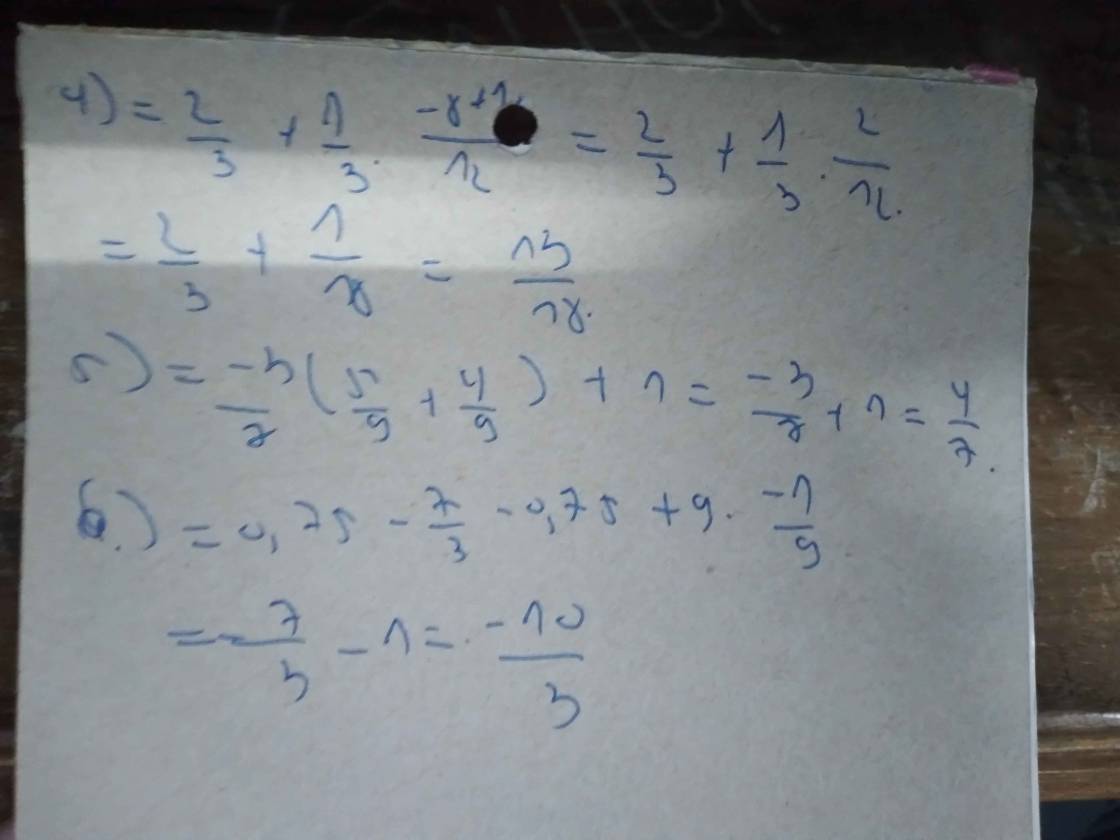(x+1)^2 - 9 = -5
Hãy nhập câu hỏi của bạn vào đây, nếu là tài khoản VIP, bạn sẽ được ưu tiên trả lời.


a) \(\dfrac{5}{7}\times\dfrac{5}{9}+\dfrac{4}{9}\times\dfrac{5}{7}\)
\(=\dfrac{5}{7}\times\left(\dfrac{4}{9}+\dfrac{5}{9}\right)\)
\(=\dfrac{5}{7}\times1\)
\(=\dfrac{5}{7}\)
b) \(\dfrac{1}{10}+\dfrac{5}{9}+\dfrac{4}{9}+\dfrac{9}{10}-1\)
\(=\left(\dfrac{5}{9}+\dfrac{4}{9}\right)+\left(\dfrac{1}{10}+\dfrac{9}{10}-1\right)\)
\(=1+0\)
\(=1\)
c) \(\dfrac{5}{7}\times\dfrac{5}{9}+\dfrac{4}{9}\times\dfrac{5}{7}+\dfrac{2}{7}\)
\(=\dfrac{5}{7}\times\left(\dfrac{5}{9}+\dfrac{4}{9}\right)+\dfrac{2}{7}\)
\(=\dfrac{5}{7}+\dfrac{2}{7}\)
\(=1\)
d) \(\dfrac{2}{7}+\dfrac{2}{8}+\dfrac{1}{4}+\dfrac{1}{7}+\dfrac{4}{7}\)
\(=\left(\dfrac{2}{8}+\dfrac{1}{4}\right)+\left(\dfrac{2}{7}+\dfrac{1}{7}+\dfrac{4}{7}\right)\)
\(=\left(\dfrac{1}{4}+\dfrac{1}{4}\right)+1\)
\(=\dfrac{1}{2}+1\)
\(=\dfrac{3}{2}\)
e) \(\dfrac{4}{5}+\dfrac{3}{10}+\dfrac{2}{10}+0,7\)
\(=\dfrac{4}{5}+\dfrac{5}{10}+\dfrac{7}{10}\)
\(=\dfrac{4}{5}+\dfrac{12}{10}\)
\(=\dfrac{4}{5}+\dfrac{6}{5}\)
\(=\dfrac{10}{5}\)
\(=2\)
g) \(362\times728+326\times272\)
\(=326\times\left(728+272\right)\)
\(=326\times1000\)
\(=326000\)

1: =-2/9(15/17+2/17)=-2/9
2: \(=\dfrac{-6}{3}+\dfrac{-21}{90}\)
=-2-7/30=-67/30
3: \(=\dfrac{3}{4}\cdot\dfrac{7}{5}+\dfrac{9}{7}\cdot\dfrac{3}{2}\)
=21/20+27/14=417/140
4: =-25/13(5/19+14/19)=-25/13
5: =-7/5-45/21=-7/5-15/7=-124/35
1: =-2/9(15/17+2/17)=-2/9
2: =−63+−2190=−63+−2190
=-2-7/30=-67/30
3: =34⋅75+97⋅32=34⋅75+97⋅32
=21/20+27/14=417/140
4: =-25/13(5/19+14/19)=-25/13
5: =-7/5-45/21=-7/5-15/7=-124/35

a: \(\dfrac{x-1}{x^2-x+1}-\dfrac{x+1}{x^2+x+1}=\dfrac{10}{x\left(x^4+x^2+1\right)}\)
\(\Leftrightarrow x\left(x-1\right)\left(x^2+x+1\right)-x\left(x+1\right)\left(x^2-x+1\right)=10\)
\(\Leftrightarrow x\left(x^3-1\right)-x\left(x^3+1\right)=10\)
=>-2x=10
hay x=-5
d: \(\Leftrightarrow\dfrac{1}{\left(x+1\right)\left(x+2\right)}+\dfrac{1}{\left(x+2\right)\left(x+3\right)}+...+\dfrac{1}{\left(x+7\right)\left(x+8\right)}=\dfrac{1}{14}\)
\(\Leftrightarrow\dfrac{1}{x+1}-\dfrac{1}{x+8}=\dfrac{1}{14}\)
\(\Leftrightarrow\left(x+1\right)\left(x+8\right)=14\left(x+8\right)-14\left(x+1\right)\)
\(\Leftrightarrow x^2+9x+8=14x+112-14x-14=98\)
\(\Leftrightarrow x^2+9x-90=0\)
\(\Leftrightarrow x\in\left\{6;-15\right\}\)

Bài 2:
a: 2/6x5/3=10/18=5/9
b: 11/9x5/10=55/90=11/18
c: 3/9x6/8=1/3x3/4=1/4
d: 4/9x12/16=48/144=1/3
e: 25/15x6/7=5/3x6/7=30/21=10/7
f: 6/10x15/20=90/200=9/20
Bài 1
4/5 x 6/7= 24/35
2/9 x 1/2= 2/18= 1/9
1/2 x 8/3= 8/6= 4/3
7/9 x 6/5= 42/45= 14/15
8/7 x 5/9= 40/63
10/11 x 22/15= 220/165= 4/3
Bài 2
2/6 x 5/3= 1/3 x 5/3=5/9
11/9 x 5/10= 11/9 x 1/2= 11/18
3/9 x 6/8= 1/3 x 3/4 =3/12= 1/4
4/9 x 12/16= 4/9 x 3/4= 12/36= 1/3
25/15 x 6/7= 5/3 x 6/7= 30/21= 10/7
6/10 x 15/20= 3/5 x 3/4= 9/20


Let's solve each equation step by step:
√(x^2 - 6x + 9) = 3 - xSquaring both sides of the equation, we get:
x^2 - 6x + 9 = (3 - x)^2
x^2 - 6x + 9 = 9 - 6x + x^2
The x^2 terms cancel out, and we are left with:
-6x = -6x
This equation is true for any value of x. Therefore, there are infinitely many solutions.
x^2 - (1/2)x + 1/16 = x + 3/2Moving all terms to one side of the equation, we get:
x^2 - (1/2)x - x + 3/2 - 1/16 = 0
x^2 - (3/2)x + 29/16 = 0
To solve this quadratic equation, we can use the quadratic formula:
x = (-b ± √(b^2 - 4ac)) / (2a)
In this case, a = 1, b = -3/2, and c = 29/16. Plugging in these values, we get:
x = (3/2 ± √((-3/2)^2 - 4(1)(29/16))) / (2(1))
x = (3/2 ± √(9/4 - 29/4)) / 2
x = (3/2 ± √(-20/4)) / 2
x = (3/2 ± √(-5)) / 2
Since the square root of a negative number is not a real number, this equation has no real solutions.
√(x - 2)√(x - 1) = √(x - 1) - 1Squaring both sides of the equation, we get:
(x - 2)(x - 1) = (x - 1) - 2√(x - 1) + 1
x^2 - 3x + 2 = x - 1 - 2√(x - 1) + 1
x^2 - 4x + 2 = -2√(x - 1)
Squaring both sides again, we get:
(x^2 - 4x + 2)^2 = (-2√(x - 1))^2
x^4 - 8x^3 + 20x^2 - 16x + 4 = 4(x - 1)
x^4 - 8x^3 + 20x^2 - 16x + 4 = 4x - 4
Rearranging terms, we have:
x^4 - 8x^3 + 20x^2 - 20x + 8 = 0
This equation does not have a simple solution and requires further calculations or approximation methods to find the solutions.
√9 - 4√5 - √5 = -2Simplifying the left side of the equation, we get:
3 - 4√5 - √5 = -2
-√5 - 5 = -2
-√5 = 3
This equation is not true since the square root of a number cannot be negative.
Therefore, the given equations either have infinitely many solutions or no real solutions.

| 9 x 1 = 9 | 9 x 2 = 18 | 9 x 3 = 27 | 9 x 4 = 36 |
| 1 x 9 = 9 | 2 x 9 = 18 | 3 x 9 = 27 | 4 x 9 = 36 |
| 9 x 5 = 45 | 9 x 6 = 54 | 9 x 7 = 63 | 9 x 8 = 72 |
| 5 x 9 = 45 | 6 x 9 = 54 | 7 x 9 = 63 | 8 x 9 =72 |

a: =91/105+60/105-101/105
=50/105=10/21
c: \(\dfrac{3}{4}\cdot\dfrac{5}{2}\cdot\dfrac{7}{6}=\dfrac{3}{6}\cdot\dfrac{7}{2}\cdot\dfrac{5}{4}=\dfrac{1}{2}\cdot\dfrac{7}{2}\cdot\dfrac{5}{4}=\dfrac{35}{16}\)
d: =2-2/9
=18/9-2/9
=16/9
e: =24/36-9/36+8/36
=23/36
g: =5/2+1/2
=3


\(\left(x+1\right)^2-9=-5\)
\(\Rightarrow\left(x+1\right)^2=-5+9\)
\(\Rightarrow\left(x+1\right)^2=4\)
\(\Rightarrow\orbr{\begin{cases}\left(x+1\right)^2=2^2\\\left(x+1\right)^2=\left(-2\right)^2\end{cases}}\)
\(\Rightarrow\orbr{\begin{cases}x+1=2\\x+1=-2\end{cases}}\)
\(\Rightarrow\orbr{\begin{cases}x=1\\x=-3\end{cases}}\)
Vậy x = 1 hoặc x = -3
\(\left(x+1\right)^2-9=-5\)
\(\Leftrightarrow\left(x+1\right)^2=-5+9\)
\(\Leftrightarrow\left(x+1\right)^2=4\)
\(\Leftrightarrow\orbr{\begin{cases}\left(x+1\right)^2=2^2\\\left(x+1\right)^2=\left(-2\right)^2\end{cases}}\)
\(\Leftrightarrow\orbr{\begin{cases}x+1=2\\x+1=-2\end{cases}\Leftrightarrow\orbr{\begin{cases}x=2-1\\x=-2-1\end{cases}\Leftrightarrow}\orbr{\begin{cases}x=1\\x=-3\end{cases}}}\)
Vậy x=1 hoặc x=-3